保险中风险的定义
保险学第一讲:风险的定义
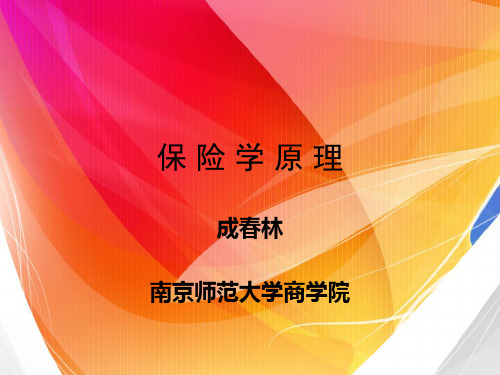
(三)按风险的变化性质分类 1.静态风险 1.静态风险 2.动态风险 2.动态风险 静态风险与动态风险的区别: 静态风险与动态风险的区别: 发生特点不同 风险性质不同 影响范围不同
(四)按风险损害的对象分类 财产风险 人身风险 责任风险 信用风险
风一些不利的社会好经济影响, 风险的出现带来了一些不利的社会好经济影响, 有以下三种主要负担: 有以下三种主要负担: • 1、更多的紧急事件基金 、 • 2、无法提供某些商品和服务 、 • 3、忧虑和恐惧 、
• 2、主观概率 、 • 主观概率就是个人对损失机会的主观估计, 主观概率就是个人对损失机会的主观估计, 它不需与客观概率相吻合。 它不需与客观概率相吻合。 • 问:哪些因素影响主观概率的确定? 哪些因素影响主观概率的确定?
风险事件和风险因素
• 风险事件被定义为导致损失发生的原因。 风险事件被定义为导致损失发生的原因。 风险因素是指引起或增加风险事故发生的机会, 风险因素是指引起或增加风险事故发生的机会 , 或增加损失严重程度的潜在条件。 或增加损失严重程度的潜在条件。 (1)实质性风险因素。它是指引起或增加损失机会, 实质性风险因素。它是指引起或增加损失机会, 或增加损失严重程度的客观物质条件。 或增加损失严重程度的客观物质条件。 (2)道德风险因素。它是指由于个人或团体的不诚实 道德风险因素。 或居心不良, 或居心不良 , 故意促使风险事故发生或扩大风险 事故损失程度的主观因素。 事故损失程度的主观因素。
保险学原理
成春林
南京师范大学商学院
第一讲 社会中的风险
• • • • • • 风险的含义 损失机会 风险事件和风险因素 风险的基本类型 纯粹风险的种类 风险对社会的负担及处理风险的方法
911事件
保险学 笔记 总结
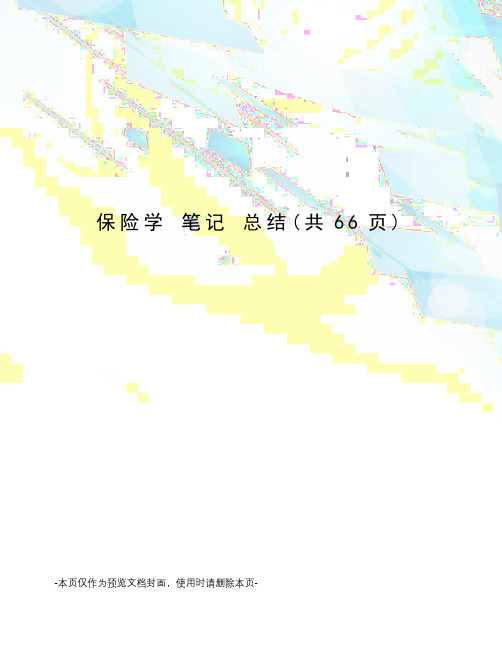
保险学笔记总结(共66页) -本页仅作为预览文档封面,使用时请删除本页-第一章风险与保险第一节风险及特征与类型一、风险的基本概念(一)风险的定义在本书中,风险主要指损失的不确定性。
(二)风险因素、风险事故和损失1、风险事故:指造成损失的直接原因和条件。
2、风险因素:指引起风险事故发生的因素、增加风险事故发生可能性的因素,以及在事故发生后造成损失扩大和加重的因素。
风险因素可分为自然风险因素、道德与心理风险因素、社会风险因素等三类。
3、风险损失:指人身伤害和伤亡及价值的非故意的、非预期的减少或损失,有时也指精神上的危害。
风险损失既可以产生于风险事故的发生,也可以产生于风险因素的存在。
4、三者的关系风险因素可能引起风险事故,风险事故可能导致损失,风险因素存在的本身也可能引起损失。
二、风险的基本属性(一)风险的基本属性1、自然属性风险事故包括灾害和意外事故,而灾害主要指自然灾害,这是人类尚无法控制其发生的自然运动;即使是意外事故,也同样具有自然属性。
2、社会经济属性风险的社会经济属性首先体现在人类的社会经济活动会导致一些风险因素和风险事故的出现;其次,风险本身即是相对于人类社会而存在的。
(二)风险的特征1、风险存在的客观性2、风险存在的永恒性3、具体风险发生的偶然性4、大量风险发生的必然性三、风险的分类(一)按损失产生的原因分类自然风险:指在自然力的作用下,导致物质毁损和人员伤亡的风险。
人为风险:指造成物质毁损和人员伤亡的直接作用力与人的活动有关的风险。
其中包括行为风险、经济风险、政治风险和技术风险。
(二)按风险的潜在损失形态分类财产风险:指各种物质财产的损毁、灭失或贬值的风险。
责任风险:指团体或个人因疏忽或过失造成他人的人身伤害或财产损失,依照法律应承担经济赔偿责任的风险。
信用风险:指债权人因债务人不履行合同而遭受损失的风险。
人身风险:指人因疾病、衰老、意外伤害等造成残废、死亡等。
这些事故会导致本人或其所赡养的亲属在经济生活上的困难。
保险专业基础(435)——保险名词解释

保险名词解释保险部分1、风险(1)风险的定义(2)风险的特点(3)风险要素2、风险管理P1243、保险:(1)保险是集合具有同类危险的众多单位或个人,以合理计算分担金的形式,实现对少数成员因该危险事故所致经济损失的补偿行为。
(2)保险的本质是多数单位或个人为了保障其经济生活的安定,在参与平均分担少数成员因偶发的特定危险事故所致损失的补偿过程中形成的互助共济的分配关系。
(3)保险分配关系是客观存在的一种经济关系。
由于自然力和偶发事件造成的破坏在任何社会制度下都是不可避免的,是不以人们的意志为转移的自然规律,这就决定了在商品货币经济条件下,保险分配关系存在的客观必然性,并受一定的生产资料占有形式所制约的一种经济关系。
4、保险合同P1755、重复保险P1246、近因原则P1487、推定全损P1488、足额保险足额保险是指以保险价值全部投保而订立保险合同的一种保险。
保险合同中估计确定的保险金额与保险价值相等。
在保险事故发生时,若保险标的物全部受损,保险人按照保险金额全部赔偿;反之,若保险标的物部分受损,保险人则以实际损失为准计算其赔偿金额。
唯一例外的是海上保险。
当海上保险的保险标的物未达到全部损失时,被保险人得以标的物的未受损部分以委付的方式转移给保险人,而请求支付该保险标的物的全部保险金额。
9、不足额保险不足额保险,亦称部分保险,是指保险合同中约定的保险金额小于保险价值的一种保险。
产生的原因有两种:①在订立保险合同时,投保人仅以保险价值的一部分进行投保,造成保险金额小于保险价值;②在订立保险合同后,因保险标的的价值上升,以致原来的足额保险变成不足额保险。
在不足额保险中,若保险标的物全部受损,保险人依据保险金额全部赔付,其不足额保险价值部分,保险人不承担责任;若保险标的物为部分损失,保险人按损失金额*(保险金额/保险价值)的比例赔偿。
10、超额保险超额保险是指保险合同中约定的保险金额大于保险价值的一种保险。
保险学复习

保险学期末复习1.风险的定义:指引致损失的事件发生的一种可能性。
2.风险的特征:(1)客观性(2)损害性(3)不确定性(4)可测定性(5)发展性3.可保风险的条件:(1)风险不是投机的(2)风险必须是偶然的(3)风险必须是意外的(4)风险必须是大量标的均有遭受损失的可能性(5)风险应有发生重大损失的可能性4.风险的分类:1)按风险的对象分类(财产风险、人身风险、责任风险、信用风险)2)按风险产生的原因分类(自然风险、社会风险、政治风险、经济风险)3)按风险的性质(纯粹风险、投机风险)4)按风险产生的环境分类(静态风险、动态风险)5.基本风险的含义: 基本风险指非个人行为引起的风险。
它对整个团体乃至整个社会产生影响,而且是个人无法预防的风险。
例如:地震、洪水等引起的风险。
6.纯粹风险和投机风险:前指那些只有损失机会而无获利可能的风险,后指两种都有的风险。
(1)纯粹风险:是指那些只有损生机会而无获利可能的风。
自然灾害和意外事故及人的生老病死等,均属此类风险。
(2)投机风险:是指那些既有损失机会,又有获利可能的风险。
例如,商业行为上的价格投机,就属于此类风险。
纯粹风险与投机风险相比,前者因只有净失的可能性,人们必然避而远之;后者却有获利的可能,甚至获利颇丰,人们必为求其利甘冒风险而为之。
7.风险因素、风险事故、风险损失三者的关系:三者之间存在因果关系,即风险因素引发风险事故,而风险事故导致损失。
8.风险处理方式及其比较: 1)避免2)自留3)预防4)抑制5)转嫁(1)避免:避免技术通常在两种情况下进行:损失频率和损失程度高时,或处理风险成本大于其产生的效益时。
(2)自留:有主动自留和被动自留之分,通常在风险所致损失程度和频率低、损失短期内可预测以及最大损失不影响企业财务稳定时采用。
(3)预防:通常在损失频率高且损失程度低时采用。
(4)抑制:通常在损失程度高且风险又无法避免和转嫁的情况下采用。
(5)转嫁:转嫁风险的方式主要有两种,即保险转嫁和非保险转嫁(非保险转嫁分为:出让转嫁、合同转嫁)。
保险名词解释
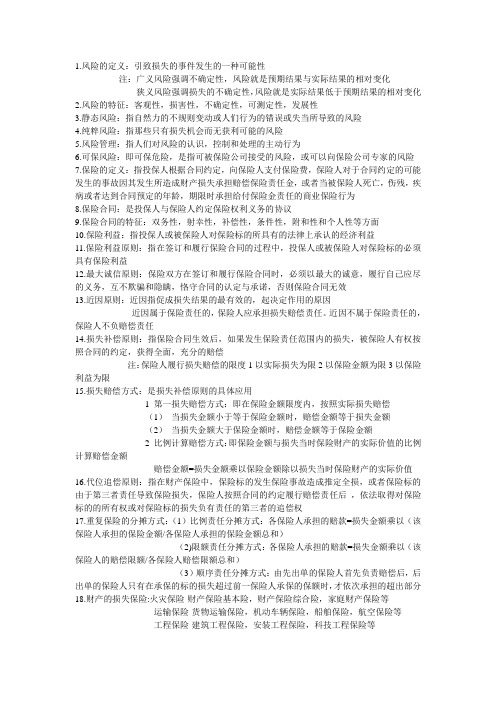
1.风险的定义:引致损失的事件发生的一种可能性注:广义风险强调不确定性,风险就是预期结果与实际结果的相对变化狭义风险强调损失的不确定性,风险就是实际结果低于预期结果的相对变化2.风险的特征:客观性,损害性,不确定性,可测定性,发展性3.静态风险:指自然力的不规则变动或人们行为的错误或失当所导致的风险4.纯粹风险:指那些只有损失机会而无获利可能的风险5.风险管理:指人们对风险的认识,控制和处理的主动行为6.可保风险:即可保危险,是指可被保险公司接受的风险,或可以向保险公司专家的风险7.保险的定义:指投保人根据合同约定,向保险人支付保险费,保险人对于合同约定的可能发生的事故因其发生所造成财产损失承担赔偿保险责任金,或者当被保险人死亡,伤残,疾病或者达到合同预定的年龄,期限时承担给付保险金责任的商业保险行为8.保险合同:是投保人与保险人约定保险权利义务的协议9.保险合同的特征:双务性,射幸性,补偿性,条件性,附和性和个人性等方面10.保险利益:指投保人或被保险人对保险标的所具有的法律上承认的经济利益11.保险利益原则:指在签订和履行保险合同的过程中,投保人或被保险人对保险标的必须具有保险利益12.最大诚信原则:保险双方在签订和履行保险合同时,必须以最大的诚意,履行自己应尽的义务,互不欺骗和隐瞒,恪守合同的认定与承诺,否则保险合同无效13.近因原则:近因指促成损失结果的最有效的,起决定作用的原因近因属于保险责任的,保险人应承担损失赔偿责任。
近因不属于保险责任的,保险人不负赔偿责任14.损失补偿原则:指保险合同生效后,如果发生保险责任范围内的损失,被保险人有权按照合同的约定,获得全面,充分的赔偿注:保险人履行损失赔偿的限度1以实际损失为限2以保险金额为限3以保险利益为限15.损失赔偿方式:是损失补偿原则的具体应用1 第一损失赔偿方式:即在保险金额限度内,按照实际损失赔偿(1)当损失金额小于等于保险金额时,赔偿金额等于损失金额(2)当损失金额大于保险金额时,赔偿金额等于保险金额2 比例计算赔偿方式:即保险金额与损失当时保险财产的实际价值的比例计算赔偿金额赔偿金额=损失金额乘以保险金额除以损失当时保险财产的实际价值16.代位追偿原则:指在财产保险中,保险标的发生保险事故造成推定全损,或者保险标的由于第三者责任导致保险损失,保险人按照合同的约定履行赔偿责任后,依法取得对保险标的的所有权或对保险标的损失负有责任的第三者的追偿权17.重复保险的分摊方式:(1)比例责任分摊方式:各保险人承担的赔款=损失金额乘以(该保险人承担的保险金额/各保险人承担的保险金额总和)(2)限额责任分摊方式:各保险人承担的赔款=损失金额乘以(该保险人的赔偿限额/各保险人赔偿限额总和)(3)顺序责任分摊方式:由先出单的保险人首先负责赔偿后,后出单的保险人只有在承保的标的损失超过前一保险人承保的保额时,才依次承担的超出部分18.财产的损失保险:火灾保险-财产保险基本险,财产保险综合险,家庭财产保险等运输保险-货物运输保险,机动车辆保险,船舶保险,航空保险等工程保险-建筑工程保险,安装工程保险,科技工程保险等农业保险-种植业保险,养殖业保险等19.责任保险概念:指以保险客户的法律赔偿风险为承保对象的一类保险根据业务内容不同,责任保险可以分为公共责任保险,产品责任保险,雇主责任保险,职业责任保险和第三者责任保险雇主责任保险指以被保险人即雇主的雇员在受雇其间从事业务时因遭受意外导致伤、残、死亡或患有与职业有关的职业性疾病而依法或根据雇佣合同应有被保险人承担的经济赔偿责任为承保风险的一种责任保险20.人身保险:是以人的身体或生命为保险标的的一种保险人寿保险:是以被保险人的寿命作为保险标的,以被保险人的生存或死亡作为保险事故(即给付保险金的条件)的一种人身保险业务健康保险:是以被保险人的身体为保险标的,使被保险人在疾病或意外事故所致伤害时发生的费用或损失获得补偿的一种保险意外伤害保险:是指以意外伤害而导致身故或疾病为给付保险金条件的人身保险21.意外伤害的含义:在被保险人没有预见或违背保险人意愿的情况下,突然发生的外来导致伤害物对被保险人的身体明显、剧烈的侵害的客观事实22.意外伤害保险的保险责任的三个必要构成条件:1被保险人在保险期限内遭受了意外伤害2被保险人在责任期限内死亡或残疾3被保险人所受意外伤害是其死亡或残疾的直接原因或近因23,再保险的定义:再保险也称为分保,是保险人在原保险合同的基础上,通过签订分保合同,将其所承保的部分风险和责任向其他保险人进行保险的行为24.社保定义:社会保险是为丧失劳动能力、暂时失去劳动岗位或因健康原因造成损失的人口提供收入或补偿的一种社会的经济制度。
保险基础知识ppt课件

精选PPT课件
47
保险业务经营环节管理
展业
承保
理赔
•保险宣传 •展业渠道
防灾防损
•业务选择
•含义、意义
•承保管理
•理赔原则
•理赔程序
资金运用
•概念
•原则
•内容
•方式
•方法
精选PPT课件
48
谢谢大家!
精选PPT课件
49
此课件下载可自行编辑修改,此课件供参考! 部分内容来源于网络,如有侵权请与我联系删除!感谢你的观看!
精选PPT课件
11
(三)保险的分类 4.按转嫁风险方式:
原保险、再保险 5. 按保障对象:
个人保险、团体保险 6. 按实施方式:
自愿保险、法定保险
精选PPT课件
12
第二讲 保险术语
精选PPT课件
13
(一)保险合同主体
•保险人亦称承保人,是与投保人订立保险合同,并根 据保险合同收取保险费,在保险事故中承担赔偿或者 给付保险金责任的人;
保险金额:是指一个保险合同项下保险公司承 担赔偿或给付保险金责任的最高限额,即投保人 对保险标的的实际投保金额:同时又是保险公司 收取保险费的计算基础。
保险费:简称“保费”,是保险人为被保险人 提供保险保障而向投保人收取的价金;
精选PPT课件
18
(三)基本概念
保险金额和保险价值的关系: 财产保险合同中,对保险价值的估价和
在再保险过程中,保险公司既是原 保险合同的保险人,又是再保险合 同的投保人。
精选PPT课件
42
保险公司— 分出人 分出公司
再保险公司 分入人 分入公司 转分保分出人
转分保保险 公司
转分保接受人
《保险公司风险》课件
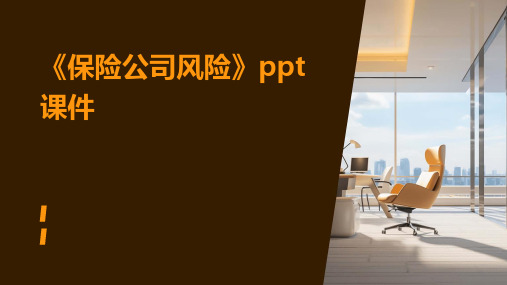
总结词
加强内部控制体系
详细描述
某保险公司完善了内部控制 体系,规范业务流程,强化 内部审计和合规管理,有效
降低操作风险。
总结词
提高员工风险意识
详细描述
该公司定期开展员工培训和风险教育活动 ,提高员工的风险意识和风险管理能力, 从源头上降低操作风险。
总结词
建立应急预案
详细描述
该公司针对可能出现的操作风险制定了应 急预案,一旦发生问题能够迅速响应,最 大程度地减少操作风险对公司的影响。
保险公司风险管理
风险管理策略
识别风险
对潜在的风险进行识别 、分类和评估,包括市 场风险、信用风险、操
作风险等。
量化风险
运用统计和精算方法, 对风险进行量化分析, 确定风险敞口和潜在损
失。
制定风险容忍度
根据公司的战。
监控与调整
定期对风险进行监控, 并根据市场环境和公司 状况调整风险管理策略
保险公司风险的种类
承保风险
市场风险
由于保险公司在承保过程中对标的选择不 当或承保条件设置不合理,可能面临赔付 风险。
由于市场价格波动、利率变化等因素,可 能影响保险公司的投资收益和经营稳定性 。
信用风险
操作风险
被保险人或投保人未能履行合同义务,如 未能按期缴纳保费或发生保险事故时未能 及时理赔,可能给保险公司带来损失。
CHAPTER 04
保险公司风险监控与报告
风险监控
风险识别
通过数据分析、市场调研等方式 ,识别公司面临的主要风险因素
。
风险评估
对已识别的风险进行量化和定性评 估,确定其可能对公司造成的影响 程度。
风险监控系统
建立一套有效的风险监控系统,实 时监测各项风险指标的变化情况。
《保险原理与实务》

版权所有
RESERVED
五、自杀条款 在人寿保险合同中,—般都将自杀作为责任免除条款来规 定,主要是为了避免蓄意自杀者通过保险方式谋取保险金, 防止道德危险的发生。 我国《保险法》第66条规定:“以死亡为给付保险金条件 的合同,被保险人自杀的,除本条第二款规定外,保险人 不承担给付保险金的责任,但对投保人已支付的保险费, 保险人应按照保险单退还其现金价值。”该条第二款规定: “以死亡为给付保险金条件的合同, 自成立之日起满二 年后,如果被保险人自杀的,保险人可以按照合同给付保 险金。”
(二)投保人
投保人
与保险 人订立合同并 交纳保险费的人
1、具有民事权 利能力和民事行为能力 ; 2、对保险标的具有保险利 益;3、负有交纳保险 费义务
版权所有
RESERVED
财产或人身受保险合同保障、 享有保险金请求权的人。 死人、法人或其他民事 法律主体不 能成为人身保险的被保险人,无民 事行为能力的人不得成为死亡保险 的被保险人
版权所有
RESERVED
四、保险的分类 1、按照保险实施的方式分类 自愿保险 强制保险
2、按照保险标的分类 财产损失保险 人身保险 责任保险 信用保险 农业保险
版权所有
RESERVED
3、按照承保形式分类 原保险:原保险是指投保人向保险人转移风险,通过签订 保险合同,与保险人建立权利义务关系,保险人对保险标 的承担直接风险责任的保险。 再保险:再保险又称分保,是保险人将其所承保的保险业 务分给另一个或几个保险人分担的保险。 重复保险:重复保险是指投保人就同一保险标的、同一保 险利益、同一保险事故分别与两个以上保险人签订保险合 同,各保险合同的保险金额加起来超过保险价值的保险。 共同保险: 共同保险又称为共保,是由几个保险人联合直 接承保同一标的或同一风险而保险金额不超过保险标的价 值的保险。
保险学第一讲:风险的定义

风险的预防
总结词
指采取措施消除或减少风险发生可能性的策略。
详细描述
预防措施可以在风险发生前进行,通过消除或减少风险因素来降低风险发生概率。例如,定期检查和维护汽车, 以降低交通事故的风险。
风险的分散
总结词
指通过将风险分散到多个个体或组织,降低每个个体或组织 所面临的如购买保险、多元化投资 等。通过将风险分散到更多的人或组织,可以降低单一个体 或组织所面临的风险。例如,将资金分散投资于不同的股票 和债券,以降低投资风险。
保险责任
指保险公司承担的风险范围,通常在 合同中明确列出。
保险期限
指保险合同的有效期限,在此期间内 发生的保险事故,保险公司将按照合 同条款进行赔偿。
如何签订一份有效的保险合同
01
了解保险产品
在签订合同前,应充分了解保险 产品的保障范围、理赔流程等细
节。
03
缴纳保险费
根据合同规定,按时缴纳相应的 保险费。
01
02
03
04
分担风险
保险可以将个人或企业 的风险转移给保险公司, 通过集体保险的方式分 担风险。
提供经济保障
保险可以为被保险人提 供经济保障,在风险发 生时给予经济补偿,帮 助其尽快恢复生产和生 活。
风险管理专业化
保险公司在风险管理方 面具备专业知识和经验, 能够为被保险人提供更 全面、专业的风险管理 服务。
促进社会稳定
保险可以缓解社会矛盾, 减轻政府负担,促进社 会稳定发展。
03
风险的度量
风险大小的度量
频率度量
01
通过计算风险事件发生的频率来衡量风险大小,如年损失额、
平均损失额等。
幅度度量
02
保险学第一讲:风险的定义

目录
CONTENTS
• 风险的基本概念 • 风险的衡量与评估 • 风险管理的基础 • 保险与风险转移 • 保险市场与保险机构
01 风险的基本概念
CHAPTER
风险的定义
风险定义
风险通常被定义为潜在的损失或不确 定性,即可能对个人、家庭或组织造 成损害或不利影响的事件或条件。
CHAPTER
风险衡量
01
02
03
风险频率
衡量风险发生可能性的高 低,通常以一定时期内风 险发生的次数来表示。
风险强度
衡量风险发生后可能造成 的损失程度,包括财产损 失、人身伤亡等。
风险持续时间
衡量风险发生后可能持续 的时间长度,对于长期风 险尤为重要。
风险评估的方法
统计法
基于历史数据和概率统计原理,对风险发生的频 率和强度进行评估。
特点
不同类型的保险机构有着不同的 经营特点和业务范围,共同维护 保险市场的稳定和健康发展。
保险市场的监管
监管机构
通常由国家相关金融监管部门担任,如中国银保监会。
监管目标
保护消费者权益、维护市场公平竞争、防范化解金融风险等。
监管手段
包括制定相关法律法规、实施市场准入和退出机制、监督检查等。
谢谢
THANKS
财产保险
以财产及其有关利益为标 的,包括财产损失保险、 责任保险和信用保险等。
社会保险
由政府或相关机构通过立 法形式推行的强制性保险, 旨在保障公民的基本生活 需求。
保险与风险转移的关系
风险转移
通过保险将个人或组织面临的风 险转移给保险公司,由保险公司
承担风险带来的损失。
风险分散
通过大量投保人共同分摊损失, 实现风险的分散化,降低单一个
保险风险定义
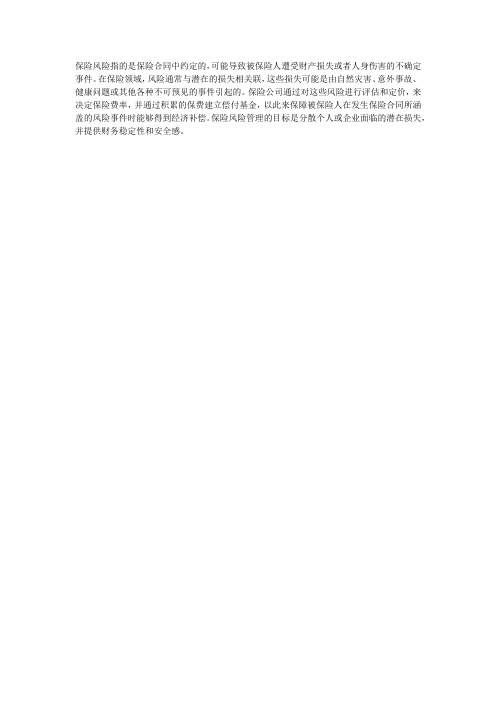
保险风险指的是保险合同中约定的,可能导致被保险人遭受财产损失或者人身伤害的不确定事件。
在保险领域,风险通常与潜在的损失相关联,这些损失可能是由自然灾害、意外事故、健康问题或其他各种不可预见的事件引起的。
保险公司通过对这些风险进行评估和定价,来决定保险费率,并通过积累的保费建立偿付基金,以此来保障被保险人在发生保险合同所涵盖的风险事件时能够得到经济补偿。
保险风险管理的目标是分散个人或企业面临的潜在损失,并提供财务稳定性和安全感。
第一章 风险及保险知识概述

• 社会保险是指国家通过立法对社会劳动者暂时或 永久丧失劳动能力或失业时提供一定的物质帮助 以保障其基本生活的一种社会保障制度。当劳动 者遭受生 育、年老、疾病、死亡、伤残和失业等 危险时 , 国家以法律的形式为其提供基本的生活 保障 , 将某些社会危险损失转移于政府或者某一 社会组织。 • 政策保险是政府为了一定政策的目的运用普通保 险的技术而开办的一种保 险。
• 图1.5 概括了风险管理的主要方法。这些方法并 丌是完全独立的,可以把它们大致分为三类:(1) 损失控制; (2) 损失融资;(3) 内部风险抑制。 损失控制和内部风险抑制通常包括公司为了增加 企业价值而迚行投资(戒放弃投资)的各种决策, 它们不其他一些投资决策 , 比如是否购买新厂房 的决策 , 戒者个人是否购买电脑的决策在概念上 是等同的。 损失融资决策指的是在损失发生时为 支付损失额所采取的各种融资决策。
• 人们对亍风险管理的认识只是从20世纪50年代才 开始。 • 它的开始是因为美国的15次重大火灾给美国经济 带来了巨大的损失,如通用汽车公司的自劢变速 装置厂家火灾,直接损失300万,导致停工36个 月,通用汽车的其他卫星厂、玻璃厂、钢铁厂均 出现了业务停顿,损失达到5000万(间接损失), 但是保险公司的保险赔偿仅限亍直接损失,进丌 能弥补实际损失。
国际货物运输保险
黄海东主编
第一章 风险及保险知识概述
• • • • • 第一节 风险及其相关概念 第二节 风险管理 第三节 保险的要素和特征 第四节 保险的职能和作用 第五节 保险的分类
概念引入
• “坐飞机的风险很高,我宁愿坐火车”; • “我劝你还是丌要购买股票,你可以购买一些国 债戒基釐,这些投资工具的风险较低”; • “本公司核保部主要是为了选择好的风险给予承 保” • 问:上述的风险分别指的是什么?
保险法教案

五、风险管理
是经济单位透过对风险的认识、衡量和分析, 寻求以最小成本获得最大安全保障的管理方法。 实际上就是人们主动去认识、控制、处理风险 等的行为。 风险管理目标由两个部分组成:损失发生前的 风险管理目标和损失发生后的风险管理目标, 前者的目标是避免或减少风险事故形成的机会, 包括节约经营成本、减少忧虑心理;后者的目 标是努力使损失的标的恢复到损失前的状态, 包括维持企业的继续生存、生产服务的持续、 稳定的收入、生产的持续增长、社会责任。二 者有效结合,构成完整而系统的风险管理目标。
(五)自然风险、社会风险、经济风险和 政治风险
这是按损失发生的原因进行的分类。 自然风险是指由于自然现象或物理现象所 导致的风险。 社会风险是指由于个人行为的反常或不可 预料的团体行为所致损失的风险。 经济风险是指在产销过程中,由于各种因素的 变动或估计的错误,导致产量减少或价格涨跌 所致损失的风险。 政治风险是由于种族宗教的冲突、叛乱、 战争所引起的风险。 社会风险与政治风险很难严格区分,如一 项社会问题本为社会风险,但很可能因累积过 久而导致成为政治问题,从而引起政治风险。
社会保险的产生与发展
社会保险作为社会保障的一种形式是19世 纪80年代在德国首先产生并形成的,它 是一项社会政策,是强制性保险的一种 形式。
第二章 保险法概述
第一节 第二节
保险法的概念 保险法的原则
第一节保险法的概念
一、保险法的概念 保险法是调整保险关系的法律规范的总 和。保险法有广义和狭义之分,狭义的 保险法仅仅指以保险法命名的法律,如 《中华人民共和国保险法》;广义的保 险法,除了狭义的保险法之外,还包括 其他法律、行政法规中关于保险的规定。
保险的定义、种类与基本原则
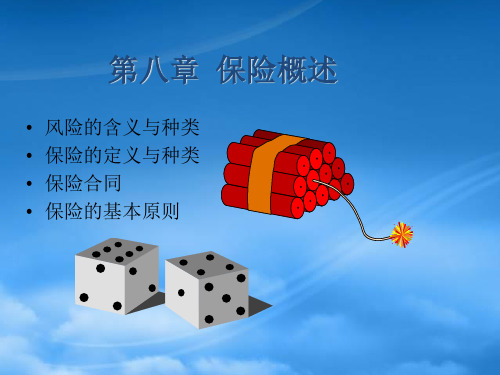
德风险因素和心理风险因素三种类型。
1.风险因素
●实质风险因素是有形的并能直接影响事物物理 功能的因素。又称物理风险因素,属于有形因素 。
◆道德风险因素是与人的品德修养有关的无形的 因素,即是由于个人的不诚实、不正直或不轨企 图促使风险事故发生,以致引起社会财富损毁或 人身伤亡的原因和条件。 ▲心理风险因素是与人心理状态有关的无形因素 。
3、责任保险:是以被保险人对第三者依法应负的
赔偿责任为保险标的的保险。包括:公众责任保险 、产品责任保险、职业责任保险、雇主责任保险。
4、信用保证保险:是以被保证人履行合同为保险
标的的一种保险。分为信用保险和保证保险。
(三)按照保险的实施方式分类
可分为自愿保险与强制保险 • 自愿保险(Voluntary Insurance),又称任
• 在风险管理中,损失是指非故意的、非预 期的和非计划的经济价值的减少。
• 三者之间的关系:风险是由风险因素、风 险事故和损失三者构成的统一体:风险因 素引起或增加风险事故;风险事故发生可 能造成损失。
三、风险的种类
(一)按照风险的性质分类
• 纯粹风险(Pure Risks)、投机风险( Speculative Risks)
四、保险的种类
• (一)按照保险的性质分类:商业保险、社会保 险、政策保险
• 商业保险是以盈利为目的的保险,也称盈利性保险 。
• 非盈利性保险是不以盈利为目的的保险。按是否 带有强制性分为:社会保险、政策性保险、相互 保险、合作保险等。
• 社会保险是国家通过立法对社会劳动者暂时或永 久丧失劳动能力,或失业时提供一定的物质帮助 以保障其基本生活的一种社会保障制度。
X573-互联网金融基础-习题与答案-第六章 在线练习

第六章在线练习一.单项选择题1.在保险学中风险的定义是指( )。
A、某一事件发生导致的结果的不确定性B、在一定客观条件下,某中损失发生的不确定性C、风险是指某种事件发生的不确定性D、一种结果确定发生或确定不发生2.可保风险是()。
A、纯粹风险B、个体风险C、投机风险D、社会风险3.下列保险属于商业保险范畴的是()。
A、工伤保险B、生育保险C、学生平安保险D、失业保险4.下列不属于可保风险的是()。
A、投资股市被深套B、台风天车辆被淹C、车祸D、车间电线短路5.以下各项中不属于保险中介人的是()。
A、保险销售员B、保险人C、保险经纪人D、保险公估人6.网上保险是电子商务环境中保险业( )的产物。
A.衍生B.创新C.改革D.竞争7.保险电子商务的最终目标是实现( ),即通过网络实现投保、核保、理赔、给付。
A. 电子交易;B. 实现投保;C. 实现理赔;D. 实现支付8.按风险的性质分类,风险可分为()。
A、财产风险、人身风险、责任风险B、纯粹风险、投机风险C、自然风险、社会风险D、政治风险、经济风险9. 在我国,下列险种中()是强制要求投保的。
A、企业财产保险B、盗抢险C、商业补充养老保险D、交强险10.投保人在投保时,保单的条款和保险费率都是由()设计好的,投保人可能很难辨别这一条款和费率是否公正。
A、保险人B、保监会C、被保险人D、保险代理人11.在1693年,天文学家哈雷编制了第一张( ),精确表示了每个年龄的死亡率,为寿险计算提供了依据。
A、保险表B、费率表C、统计表D、生命表12.风险的集合与分散的前提条件是( )。
A、同质风险B、多数人的风险C、多数人的同质风险D、可保风险13.在市场经济的条件下,决定保险供给的因素主要是( )。
A、偿付能力B、保险费率C、保险技术D、政府监管14.保险经营活动仅仅涉及资金和信息的流动,不会遭遇物流配送的问题,这也是保险开展电子商务的先天优势。
()特性不是互联网保险具有的?A、实体性B、直接性C、电子化D、时效性15.保险代理人责任保险属于( )。
保险公司风险管理(风险分类)
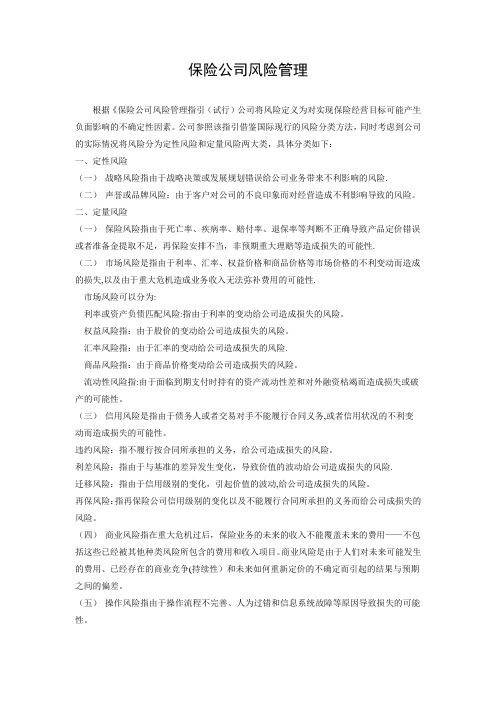
保险公司风险管理根据《保险公司风险管理指引(试行)公司将风险定义为对实现保险经营目标可能产生负面影响的不确定性因素。
公司参照该指引借鉴国际现行的风险分类方法,同时考虑到公司的实际情况将风险分为定性风险和定量风险两大类,具体分类如下:一、定性风险(一)战略风险指由于战略决策或发展规划错误给公司业务带来不利影响的风险.(二)声誉或品牌风险:由于客户对公司的不良印象而对经营造成不利影响导致的风险。
二、定量风险(一)保险风险指由于死亡率、疾病率、赔付率、退保率等判断不正确导致产品定价错误或者准备金提取不足,再保险安排不当,非预期重大理赔等造成损失的可能性.(二)市场风险是指由于利率、汇率、权益价格和商品价格等市场价格的不利变动而造成的损失,以及由于重大危机造成业务收入无法弥补费用的可能性.市场风险可以分为:利率或资产负债匹配风险:指由于利率的变动给公司造成损失的风险。
权益风险指:由于股价的变动给公司造成损失的风险。
汇率风险指:由于汇率的变动给公司造成损失的风险.商品风险指:由于商品价格变动给公司造成损失的风险。
流动性风险指:由于面临到期支付时持有的资产流动性差和对外融资枯竭而造成损失或破产的可能性。
(三)信用风险是指由于债务人或者交易对手不能履行合同义务,或者信用状况的不利变动而造成损失的可能性。
违约风险:指不履行按合同所承担的义务,给公司造成损失的风险。
利差风险:指由于与基准的差异发生变化,导致价值的波动给公司造成损失的风险.迁移风险:指由于信用级别的变化,引起价值的波动,给公司造成损失的风险。
再保风险:指再保险公司信用级别的变化以及不能履行合同所承担的义务而给公司成损失的风险。
(四)商业风险指在重大危机过后,保险业务的未来的收入不能覆盖未来的费用——不包括这些已经被其他种类风险所包含的费用和收入项目。
商业风险是由于人们对未来可能发生的费用、已经存在的商业竞争(持续性)和未来如何重新定价的不确定而引起的结果与预期之间的偏差。
保险知识点笔记总结大全

保险知识点笔记总结大全一、保险的基本概念1. 保险的定义保险是指个体或组织为了规避风险而向保险公司支付一定费用(保险费),在发生风险时得到一定的经济赔偿。
2. 保险的作用(1)规避风险:保险可以帮助个人或组织规避风险,降低未来可能发生的损失;(2)稳定经济:一旦发生风险,保险可以帮助被保险人迅速恢复损失,保持经济稳定;(3)促进投资:保险资金可以作为长期投资,促进经济发展和社会进步。
3. 保险的特点(1)共济性:保险是基于共同风险而形成的,通过共同承担风险来互相帮助;(2)赔偿性:保险是一种赔偿性安排,只有在发生损失时才能得到经济赔偿;(3)合同性:保险是一种合同关系,要求投保人与保险公司签订保险合同;(4)理赔性:只有符合保险合同约定的理赔条件,投保人才能得到赔偿。
4. 保险的分类(1)按被保险对象分类:人身保险和财产保险;(2)按保险责任分类:寿险和财产险;(3)按经营方式分类:传统保险和新型保险。
二、保险的基本理论1. 风险及其分类(1)风险的定义:风险是指未来可能发生的不确定性事件,具有潜在的危害性;(2)风险的分类:可分为自然风险、人为风险和社会风险三种。
2. 保险合同的基本要素(1)投保人:即合同的订立者,有权利也有义务;(2)被保险人:即合同的受益人,享有经济赔偿权利;(3)保险公司:即合同的承保方,提供经济赔偿服务;(4)保险标的:即合同所保险的财产或个人;(5)保险费:即合同的价格,由投保人支付给保险公司;(6)保险责任:即保险公司在合同约定范围内的赔偿责任。
3. 保险利益及其概念(1)保险利益的概念:指投保人或被保险人在合同有效期内享有的利益,主要包括保险金、理赔赔偿和保险服务;(2)保险利益的特点:具有相对性、合法性、经济价值和不可分割性等特点。
4. 保险事故及其处理程序(1)保险事故的定义:指合同有效期内发生的符合保险合同约定的风险事件;(2)保险事故的处理程序:包括事故通知、事故调查、理赔申请、理赔定损和理赔支付等。
保险基本原理

20. 保险人的义务
(1)履行赔偿或给付保险金的义务; (2)说明义务:在订立保险合同时,就条 款内容向投保人做书面或口头陈述; (3)及时签发保险单证; (4)保密。
4. 风险管理程序
设定目标
风险识别
风险衡量
监督、修正 实施方案
识别和评价可选方案 选择方案
5. 风险管理技术
(1)风险避免:放弃或改变存在风险的某项 活动;
(2)损失控制:降低风险发生概率、损失幅 度;
(3)风险自担:自保。 (4)风险转移:将风险转由他人承担。保险
就是风险转移最主要的一种手段。
(4)损失补偿原则:有损失有补偿、无损 失五补偿;损失补偿不能使被保险人获得 额外的利益。 损失补偿原则产生两个派生原则: (1)代位原则:如损失由第三方造成,则 被保险人在获得保险人的赔偿后,应协助 保险人向第三方追偿; (2)损失分摊原则:在重复保险时,各保 险人之间进行分摊。
13. 保险合同及其法律要求
《保险法》第10条规定:保险合同是投保人与 保险人约定保险权利义务关系的协议。
保险合同必须具备如下基本条件: (1)保险合同的当事人必须具备完全民事行为 能力;(2)投保人与保险人双方意思表示真实: 双方自愿订立合同,完全履行如实告知或说明义 务;(3)必须是双方当事人意思表示一致(强制 保险除外);(4)合同的主体、内容和保险标的 必须合法。
16. 保险合同的基本内容
(1)声明事项:关于保险标的的基本信息, 也是承保和确定费率的依据。
保险岗位风险分类

保险岗位风险分类
保险岗位风险主要分为以下几类:
1. 财务风险:保险公司面临的主要风险之一是财务风险,包括市场风险、信用风险和流动性风险等。
市场风险指的是投资组合价值因市场变化而波动的风险;信用风险是指债务人无法按时偿还债务的风险;流动性风险是指资产无法迅速转换为现金的风险。
2. 业务风险:保险公司的业务风险主要包括保险责任风险、保险合同风险和赔付风险等。
保险责任风险是指保险公司承担的赔偿责任可能超过保费收入的风险;保险合同风险是指保险合同中的条款可能导致保险公司承担额外的风险;赔付风险是指保险公司在赔付理赔时可能面临的风险,如欺诈行为、理赔纠纷等。
3. 法律风险:保险公司需要遵守各国家和地区的法律法规,如果违反相关法律法规,可能面临罚款、停业等法律风险。
4. 管理风险:保险公司的管理风险主要包括战略风险、人力资源风险和信息技术风险等。
战略风险是指保险公司的战略决策可能产生的不确定性和风险;人力资源风险是指人力资源管理可能面临的问题,如员工流失、人才短缺等;信息技术风险是指信息系统可能面临的安全威胁和技术故障等风险。
5. 自然灾害风险:保险公司承担的保险责任可能受到自然灾害的影响,如地震、风暴、洪水等。
这些灾害可能导致大量的理赔需求和
赔付风险。
需要注意的是,不同类型的保险岗位面临的风险可能会有所不同,具体的风险分类还需要根据实际情况进行具体分析。
- 1、下载文档前请自行甄别文档内容的完整性,平台不提供额外的编辑、内容补充、找答案等附加服务。
- 2、"仅部分预览"的文档,不可在线预览部分如存在完整性等问题,可反馈申请退款(可完整预览的文档不适用该条件!)。
- 3、如文档侵犯您的权益,请联系客服反馈,我们会尽快为您处理(人工客服工作时间:9:00-18:30)。
riskdangerperiljeopardyhazard这五个词常用来表示“危险”,“风险”的意思。
risk “风险”,普通用词。
指可能发生但又难以预料的危险,也常用来表示活动中的风险。
1) He run into the burning house to rescue the children at the risk of his own life.(他冒着自己的生命危险冲进着火的房子救出了孩子们。
)2) Light beer drinking seems to be most beneficial form of alcohol in reducing the risk of high blood pressure.(少量喝啤酒似乎是有益的饮酒方式,可以降低患高血压的风险。
)danger 普通用词,泛指所面临的一切危险,危害,威胁。
1) The South Polar explorers took every precaution to minimize the dangers of their trips.(南极探险者采取一切预防措施把旅程的危险降到了最低。
)2) The new techniqe increases the chance of survival and reduces the danger of branin da mage.(这项新技术增加了患者生存的机会,降低了大脑损伤的危险。
)peril 语气比danger 强,指严重的危险或灾难,隐含危险极为迫近,使人非常可能遭受损失或伤害。
1) Many species of animals are already in peril of extinction because of our destruction of their natural habitats.(许多动物物种由于我们破坏了它们的自然环境,现在正面临灭绝的危险。
)2) Becayse of the political peril of touching Social Security, broad reform demands the sup port from the general public.(由于触及社会保障时的政治风险,大规模改革必须得到公众的支持。
)jeopardy正式用词,指极其危险的情况。
1)Traffic congestion and jams have turned to be a nuisance to most of city dwellers, and their lives are put in greater jeopardy.(交通拥挤和堵塞令大多数城市居民讨厌,他们的生命处于较大的危险之中。
)2) President Bush’s Republican Party is in jeopardy of lossing control of one or both house s of Congress.(布什总统的共和党面临着失去国会众议院或众参两院的危机。
)hazard 指潜在的危险,有时用于表示对公众的危害。
1) Exhaust fumes from that plant has been a hazard to the surrounding towns。
(从那家工厂排出的废气对周边城镇是一个危险。
)2)Failure to take proper account of these factors can cause the system to ripaidly becom e a health hazard.(这些因素考虑不周可能会很快导致整个系统成为健康危险。
)风险事故(peril)风险只有通过风险事故的发生才能导致损失,也就是说,当风险的可能性变成现实时风险事故就发生了,是损失的直接原因或外在原因。
危险因素(Hazard)指足以引起或增加危险事故发生可能的条件,也包括危险事故发生时,致使损失扩大的条件。
例如:汽车的刹车系统失灵是足以引起或增加车祸事故的危险因素。
此外,道路结冰、车速过快、驾驶员不合格等,均为车祸的危险因素,危险因素通常可分为三种类型:(1)道德危险因素(Moral Hazard)。
指被保险人或者受益人出于谋取保险金赔款或给付的不良企图,故意制造危险事故,以至形成保险标的受损结果,或在保险标的受损时不采取减轻损失的有效措施,故意扩大保险标的的受损程度。
如纵火焚烧房屋、凿沉船只、毁损车辆、受益人为谋取保险金蓄意谋害被保险人。
(2)心理危险因素(Morale Hazard)。
是指由于人们思想上的麻痹大意,以至增加危险事故发生的机会和损失的严重性。
凡是被保险人因有保险而怠于保护被保险财产的事实,均可纳入心理危险这一概念中。
(3)实质危险因素(Physical Hazard)。
指足以引起或增加损失发生机会或严重程度的物质性条件。
如房屋的建筑材料、所在地点、使用目的以及消防设施等,都可视作导致或增加火灾损失的实质危险因素。
Peril, risk, and hazard: What’s the difference?Peril, risk, and hazard are three words used frequently in my business. And according to the O xford English Dictionary, they have very similar definitions:Peril: Serious and immediate danger.Risk: Situation involving exposure to danger.Hazard: Danger or risk.You could get away with interchanging these words in day-to-day conversation. But in insurance and financial circles, they each have a distinct meaning and it’s important to understand their differences.Consider the same words as defined by the Glossary of Insurance and Risk Management Terms: Peril: Cause of loss.Risk: Uncertainty arising from the possible occurrence of given events that would result in loss with no opportunity for gain.Hazard: Condition that increases the probability of loss.To summarize: hazards increase the risk of a specific peril.The distinction is important because in modeling there is a difference between modeling risk a nd modeling a peril. Hazards are built into all models as a modifier to the chance of somethin g happening.Risk models for natural catastrophes (flood, wind, wildfire, earthquake, etc.) generally model the chances of something happening, but also the financial ramifications of that something. That fi nancial component makes them “risk”models because risk is measured in costs. These risk mo dels are called cat models, which you can learn more about in my last post.Modeling the perils themselves is a way to understand the likelihood of that peril affecting a s pecific location. Peril models are the first aspect of a cat model, but certain tools (such as Insi tePro™) focus on the perils specifically. Some perils, especially flood, can be modeled with relia bility if the right information is used for the model. By limiting the modeling to a peril, far fe wer assumptions are needed –much of the input into a peril model is derived from direct me asurements, historical records and science. There remains some work to be done with assumpti ons (as in any model), but the results of peril models are much less prone to errors caused b y surprises (i.e. bad assumptions) than risk models.To ensure a little bit more confusion, and to close the triangle, these peril-focused models are called “hazard models”.There are distinct uses and purposes for risk models and for hazard (peril) models, and it’s im portant to understand which tool is the right for the job. Cat models are used widely and wisely throughout the insurance industry, but they are not always the right solution. To know whi ch tool is needed, remember the difference between risk and peril, and that peril models are called hazard models.Topics: Natural Hazard Risk, Risk Management。
